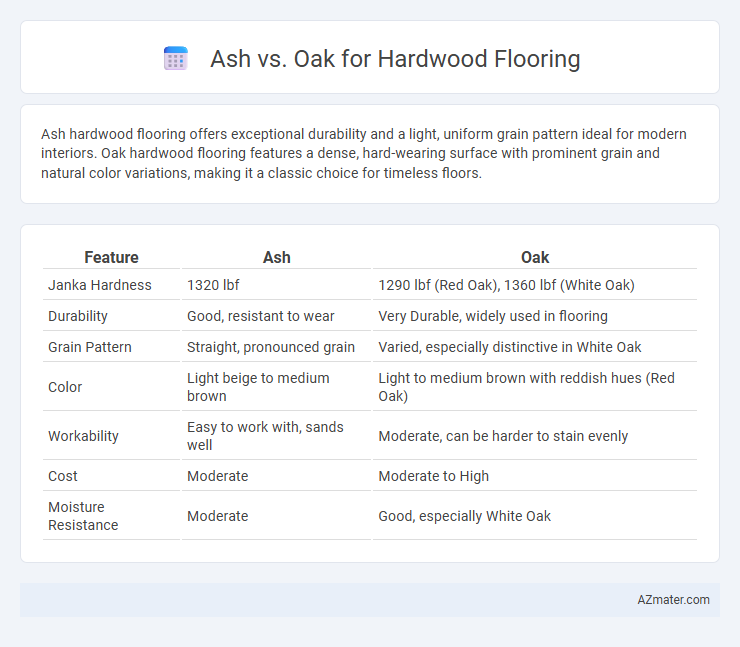Ash hardwood flooring offers exceptional durability and a light, uniform grain pattern ideal for modern interiors. Oak hardwood flooring features a dense, hard-wearing surface with prominent grain and natural color variations, making it a classic choice for timeless floors.
Table of Comparison
| Feature | Ash | Oak |
|---|---|---|
| Janka Hardness | 1320 lbf | 1290 lbf (Red Oak), 1360 lbf (White Oak) |
| Durability | Good, resistant to wear | Very Durable, widely used in flooring |
| Grain Pattern | Straight, pronounced grain | Varied, especially distinctive in White Oak |
| Color | Light beige to medium brown | Light to medium brown with reddish hues (Red Oak) |
| Workability | Easy to work with, sands well | Moderate, can be harder to stain evenly |
| Cost | Moderate | Moderate to High |
| Moisture Resistance | Moderate | Good, especially White Oak |
Introduction to Ash vs Oak Hardwood Flooring
Ash and oak are two popular hardwood flooring options known for their durability and aesthetic appeal. Ash features a light color palette with distinctive grain patterns, making it ideal for creating bright and spacious interiors. Oak offers a classic look with richer tones and exceptional hardness, suitable for high-traffic areas and traditional or modern settings.
Key Characteristics of Ash Hardwood Flooring
Ash hardwood flooring features a light to medium brown color with a distinct creamy appearance and prominent grain patterns, offering a bright and airy aesthetic. It boasts exceptional hardness and durability, scoring around 1320 on the Janka hardness scale, making it resistant to dents and wear while providing long-lasting performance. The wood's excellent shock resistance and flexibility make it ideal for high-traffic areas, while its ability to accept stains allows for versatile design options.
Key Characteristics of Oak Hardwood Flooring
Oak hardwood flooring is renowned for its durability and prominent grain patterns, which range from straight to wavy, adding a natural texture to interiors. The wood's hardness rating on the Janka scale is approximately 1,290 for red oak and 1,360 for white oak, making it highly resistant to wear and dents. Oak's natural color spectrum varies from light beige to medium brown with reddish hues, allowing versatile design options for both traditional and modern settings.
Durability Comparison: Ash vs Oak
Ash hardwood flooring offers impressive durability with a Janka hardness rating around 1320, making it resistant to dents and wear in high-traffic areas. Oak, especially Red Oak with a Janka rating near 1290 and White Oak around 1360, provides a similar or slightly higher durability level, excelling in scratch and impact resistance. Both woods are excellent choices for hardwood flooring, but White Oak's higher density offers superior longevity in demanding environments.
Color and Grain Differences
Ash hardwood flooring features a light to medium brown color with subtle golden hues, creating a warm and inviting ambiance. Its grain pattern is characterized by pronounced, straight, and uniform lines with occasional cathedral patterns, offering a visually striking and dynamic appearance. Oak flooring ranges from light tan to deep reddish-brown, with more pronounced grain variation including prominent rays and knots that add rustic charm and texture to interior spaces.
Installation and Maintenance
Ash hardwood flooring offers a straightforward installation process due to its consistent grain and hardness, making it ideal for both nail-down and glue-down methods. Oak flooring, widely favored for its durability, requires precise acclimation and moisture control during installation to prevent warping. Maintenance for ash floors involves regular sweeping and occasional refinishing to preserve its lighter tone, while oak demands routine cleaning and can tolerate more frequent refinishing due to its resilient surface.
Cost Analysis: Ash vs Oak Flooring
Ash hardwood flooring generally costs between $8 and $12 per square foot, making it a more budget-friendly option compared to oak, which typically ranges from $10 to $15 per square foot. Ash offers a durable surface with a lighter color palette that can reduce the need for additional staining or finishing expenses, while oak's natural hardness and wide grain patterns may require more maintenance over time. Overall, the initial lower cost of ash combined with its resilience presents a cost-effective alternative to oak, especially for large-scale flooring projects.
Environmental Impact and Sustainability
Ash hardwood flooring offers a more sustainable choice due to its rapid growth rate and abundance in North American forests, making it a renewable resource with a lower environmental footprint. Oak flooring, while durable and popular, generally requires longer growth periods and more intensive forestry practices, which can contribute to higher environmental impact through habitat disruption and carbon emissions. Choosing ash supports sustainable forestry management, whereas selecting oak demands careful sourcing from certified suppliers to minimize ecological harm.
Best Applications for Ash and Oak Flooring
Ash hardwood flooring excels in high-traffic areas due to its superior shock resistance and durability, making it ideal for living rooms and hallways. Oak flooring offers excellent versatility and moisture resistance, suited for kitchens and bathrooms where durability and water tolerance are crucial. Both species provide distinct grain patterns, with ash showcasing lighter, straighter grains and oak displaying prominent, varied textures, influencing design preferences in residential and commercial spaces.
Which Hardwood Flooring is Right for You?
Ash hardwood flooring offers a light, creamy color with prominent grain patterns that enhance brightness and create a spacious feel, making it ideal for contemporary and rustic designs. Oak hardwood flooring provides exceptional durability with a rich range of colors from light to deep reddish-brown and a classic grain, suitable for high-traffic areas and traditional aesthetics. Choosing between Ash and Oak depends on your preference for color tones, grain visibility, and the flooring's ability to withstand wear in your living space.

Infographic: Ash vs Oak for Hardwood Flooring
 azmater.com
azmater.com